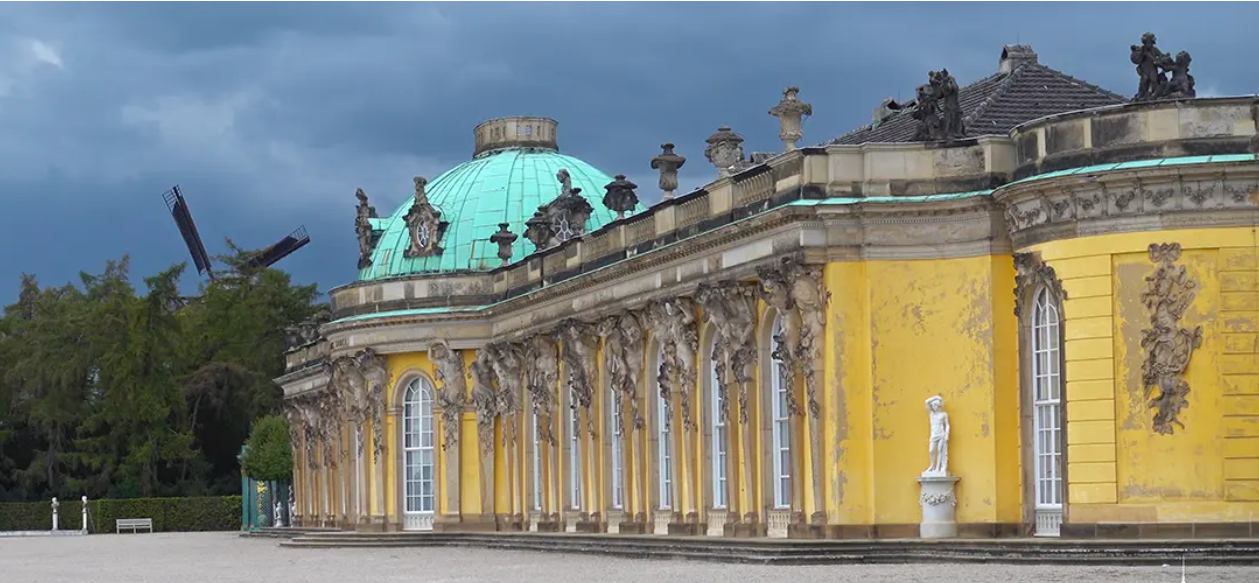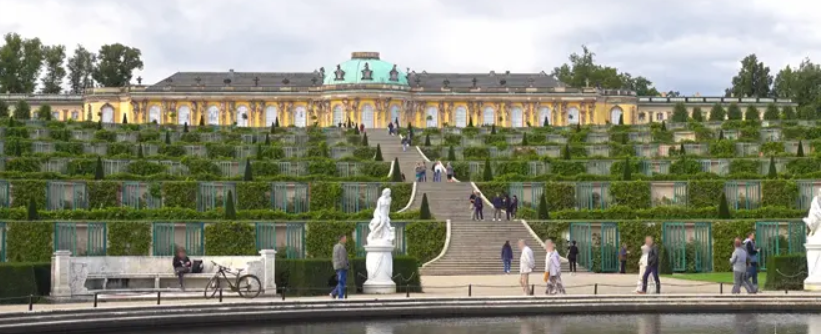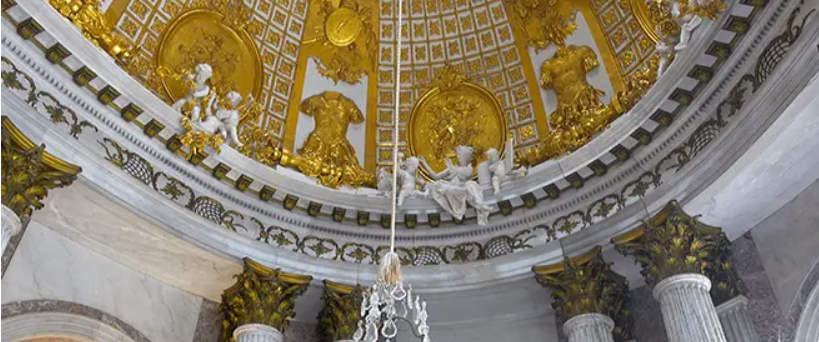The Prussian Versailles
Address: Sanssouci Palace and Sanssouci Park, Maulbeerallee, 14469 Potsdam | Built: 1745 to 1747 | Architectural style: Frederickian Rococo
Sanssouci Palace and Sanssouci Park in Potsdam were Frederick the Great’s favorite place. He had his summer palace built on the vineyard terraces. The palace and its park were his refuge, where he and his dogs retreated during difficult times. Even when minor repairs needed to be carried out by craftsmen, Frederick the Great only allowed this with reluctance. The palace was only meant to last until his death. Fortunately, his wish was never fulfilled, so Sanssouci Palace and the park are still preserved in their full beauty today.
Directions and location of this Potsdam landmark
One of the most famous palaces of the Hohenzollern family is Sanssouci Palace. It is located in the eastern part of a large park, Sanssouci Park. Sanssouci, which translates as “without worry,” was the place where Frederick the Great stayed to enjoy life away from his official duties.
The B273 runs past Sanssouci Palace and Sanssouci Park. The large park is framed on one side by the street Am Grünen Gitter, which later becomes
Opening Hours and Tours
Sanssouci Palace has different opening hours depending on the season. The opening hours are divided into the winter season, which runs from November to March, and the summer season, from April to October. Sanssouci Palace is closed on Mondays and therefore cannot be visited.
The opening hours for the interior of the palace are as follows:
Sanssouci Palace Opening Hours
Winter Season Opening Hours:
Tuesday to Sunday 10:00 a.m. to 4:30 p.m.
Summer Season Opening Hours:
Tuesday to Sunday 10:00 a.m. to 5:30 p.m.
Visitors are admitted to Sanssouci Palace until 30 minutes before closing time.
The visit is linked to a set admission time. Tickets can be purchased at the Historic Mill Visitor Center starting 30 minutes before the palace opens its doors to visitors. Sanssouci Palace is also open on public holidays. These are clearly listed by date at https://www.spsg.de/schloesser-gaerten/oeffnungszeiten/.
Sanssouci Park is open year-round from 6:00 a.m. to 10:30 p.m.

Admission Prices for Sanssouci Palace and Sanssouci Park
There is no admission fee to visit Sanssouci Park. However, visitors can voluntarily donate a few euros to support the preservation and maintenance of the park.
Those wishing to visit Sanssouci Palace can purchase a ticket at the palace ticket office, the visitor center, or online. Upon ticket purchase, a fixed entry time is also set for visiting Sanssouci Palace.
Sanssouci Palace in Potsdam Admission Prices
Admission Price:
€14.00
Reduced Admission Price:
€10.00
Reduced admission is available for people with disabilities, those receiving citizen’s income, basic social security benefits, or social assistance, as well as for children under 7 years of age.
Guided Tours of Sanssouci Palace and Sanssouci Park
Guided tours of Sanssouci Palace are led by a trained guide. Such a tour lasts approximately 50 minutes and offers interesting insights into the restored building and the splendor and prosperity of the time.
An audio guide is also available for a tour of Sanssouci Palace. These are available in various languages, so everyone can learn a lot about Sanssouci Palace. The audio guides are available free of charge when visiting the palace.
Guided tours of Sanssouci Park are also offered. A park tour features entertaining stories and anecdotes revolving around the park and the courtly activities. It also highlights more hidden spots, including the Sicilian Garden and the Marly Garden.
FAQ – Frequently Asked Questions about Sanssouci Palace
When was Sanssouci Palace built?
Sanssouci Palace in Potsdam was built between 1745 and 1747 under the reign of the Prussian King Frederick II, also known as Frederick the Great.
Which king resided at Sanssouci?
Sanssouci Palace in Potsdam was used as a royal summer residence by Frederick II, also known as Frederick the Great. Frederick the Great was King of Prussia and ruled from 1740 to 1786. During his reign, he spent many summer months at Sanssouci, using the palace as a retreat and place for relaxation and culture.
What does the name Sanssouci mean?
The name “Sanssouci” comes from French and means “without worry” or “carefree” in German. King Frederick II of Prussia chose this name for his palace to emphasize the relaxed and carefree atmosphere of the place, which served as a retreat from the duties and worries of the royal court.
How big is Sanssouci Park?
Sanssouci Park covers an area of approximately 300 hectares. It is a sprawling park that includes Sanssouci Palace as well as many other historic buildings, gardens, vineyards, forests, ponds, and walking paths.
How many rooms are there in Sanssouci Palace?
Sanssouci Palace has a total of 13 rooms. It is comparatively small compared to other royal residences, but nevertheless of great artistic and historical significance.
Sanssouci Palace and Sanssouci Park – Special Features and Interesting Facts
Sanssouci Palace and Sanssouci Park are a special experience in Potsdam. Upon entering the building, visitors are greeted by elegant and stylish furnishings, which are evident in every room and are still preserved in their original state.
There is no other palace with which Frederick the Great was so closely associated and which reflects his personality in such a unique way. Sanssouci, which translates as “without worry,” was not only a great wish of Frederick the Great, but also his leitmotif.
Especially in difficult times, Frederick the Great retreated to this palace with his dogs. Located on the famous vineyard terraces, the palace still retains its 18th-century furnishings. Visitors to Sanssouci can immerse themselves deeply in the world of Frederick the Great.
Visitors can expect rooms in which splendor unfolds in style and elegant features immediately catch the eye. Frederick the Great’s love for the wonderful surroundings is palpable in every corner of Sanssouci Palace and Sanssouci Park.
Beneath the terraces of Sanssouci Palace lies a Baroque garden with a large fountain at its center. The extensive park was designed in the 19th century by the Prussian garden designer Lenné.
A stroll through the park landscape reveals enchanting gems. Visitors to the park will come across a playful Rococo pavilion and the historic mill. There are so many different features to discover that are sometimes not immediately obvious. Therefore, even while strolling through the extensive park, it’s always worth taking a closer look to appreciate how garden design and architecture uniquely blend together.
Even after his death, Frederick the Great wanted to be close to Sanssouci Palace. Therefore, he wanted to be buried in a crypt on the upper terrace. This wish was not fulfilled until 1991.

Historical information and history of Sanssouci Palace and Sanssouci Park
Sanssouci Palace and Sanssouci Park are among the most significant ensembles of the 18th century and were designed according to the wishes and ideas of Frederick the Great.
The single-story building was modeled on a French pleasure palace. The plans for the palace were drawn up by Georg Wenzeslaus von Knobelsdorff. After a construction period of only two years, Sanssouci Palace was completed in 1747.
The palace is considered a masterpiece of Frederickian Rococo. The palace’s name, “without worry,” is reflected everywhere, not only in its location, but also in its structure and the figures that adorn the palace.
The oval Marble Hall, where Frederick II held his round table meetings, is located beneath the impressive dome. Much of the 18th-century furnishings of the rooms have survived to this day. Visitors encounter Frederick the Great and his love of music and literature everywhere in Sanssouci Palace. The palace has always been considered a cultural meeting place.
Sanssouci Park was also created during the reign of Frederick the Great. Since then, the park has developed into a unique arrangement of plantings and trees that give the 290-hectare park a special character.
There, the park can be explored along almost 70 kilometers of paths. Sanssouci Park is the largest park in Brandenburg. The spiritual center of the park is Sanssouci Palace. Visitors walk along the main avenue, past ornamental and vegetable gardens, to an obelisk and the New Palace. The signature of garden artist Peter Joseph Lenné, who designed the park with its impressive buildings, can be found everywhere.


Sights and attractions in the immediate vicinity of Sanssouci Palace
If you’re looking for something interesting and worth seeing, all you have to do is walk through Sanssouci Park. The vast expanse is home to numerous fountains, sculptures, and various buildings that are particularly worth seeing. You could easily spend an entire day in Sanssouci Park and still not have discovered everything.
The park features a magical Orangery Palace with impressive, playful elements, a small Chinese tea pavilion, the New Palace, the Church of Peace in the Marly Garden, and, on the uppermost terrace, the tomb of Frederick the Great.
Also worth seeing in Sanssouci Park is the Musenrondell (Roundabout of the Muses), near which are the Frog Fountain and the Sicilian Garden.
The Neptune Grotto, the Obelisk Portal, and the Villa Illaire are located directly next to Sanssouci Palace.
Those walking through Sanssouci Park to the New Palace will pass the Rehgarten (Deer Garden) and come across the Friendship Temple, the Temples of Antiquity, and the private gardens of the imperial family.
No matter which path you take in Sanssouci Park, there are buildings, fountains, and water features to marvel at everywhere, all dating back to the time of King Frederick II and reflecting the unique personality of Frederick the Great.
Cafés and restaurants near Sanssouci Palace and Sanssouci Park
A tour of Sanssouci Palace and a leisurely stroll through the park can be perfectly rounded off with delicious coffee specialties or tasty cakes. Several cafés and restaurants in the area surrounding the palace and park cater to your culinary needs.
Café Repin is located near the Picture Gallery on Gregor-Mendel-Straße and is open to guests on Saturdays, Sundays, and Mondays from 1:00 PM to 6:00 PM. The menu includes coffee specialties and cakes, which are also served on the outdoor terrace when the weather is nice.
Address: Café Repin, Gregor-Mendel-Straße 14
The Dragon House is located at Maulbeerallee 4 in an impressive building complex, directly in Sanssouci Park. The restaurant and café offers guests fine dining. The menu features culinary delights of seasonal German cuisine, lovingly prepared.
Address: Drachenhaus, Maulbeerallee 4
Lottenhof / Bill’s Kitchen
Located near Charlottenhof Palace, Lottenhof / Bill’s Kitchen is located on Geschwister-Scholl-Straße. Guests sit in a cozy atmosphere and can choose from a variety of dishes, such as cheese spaetzle, fried cauliflower, Kaiserschmarrn, or venison goulash, prepared in a unique culinary style.
Address: Lottenhof / Bill’s Kitchen, Geschwister-Scholl-Straße 34
The Mövenpick restaurant is located between the historic mill and Sanssouci Palace. There is a beautiful sun terrace, a beer garden, and the Palmensaal (Palm Hall) where you can relax and enjoy your meal. The menu offers a varied selection of dishes, ranging from delicious salads and soups to select main courses and special breakfast creations.
Address: Mövenpick Restaurant, Zur Historischen Mühle 2
The Augustiner im Bürgerbahnhof is located next to the “Park Sanssouci” train station on Geschwister-Scholl-Straße. The lovingly renovated building offers its guests a cozy atmosphere and a menu featuring traditional Bavarian fare, other delicacies, and an extensive drinks list.
Address: Augustiner im Bürgerbahnhof, Geschwister-Scholl-Straße 37